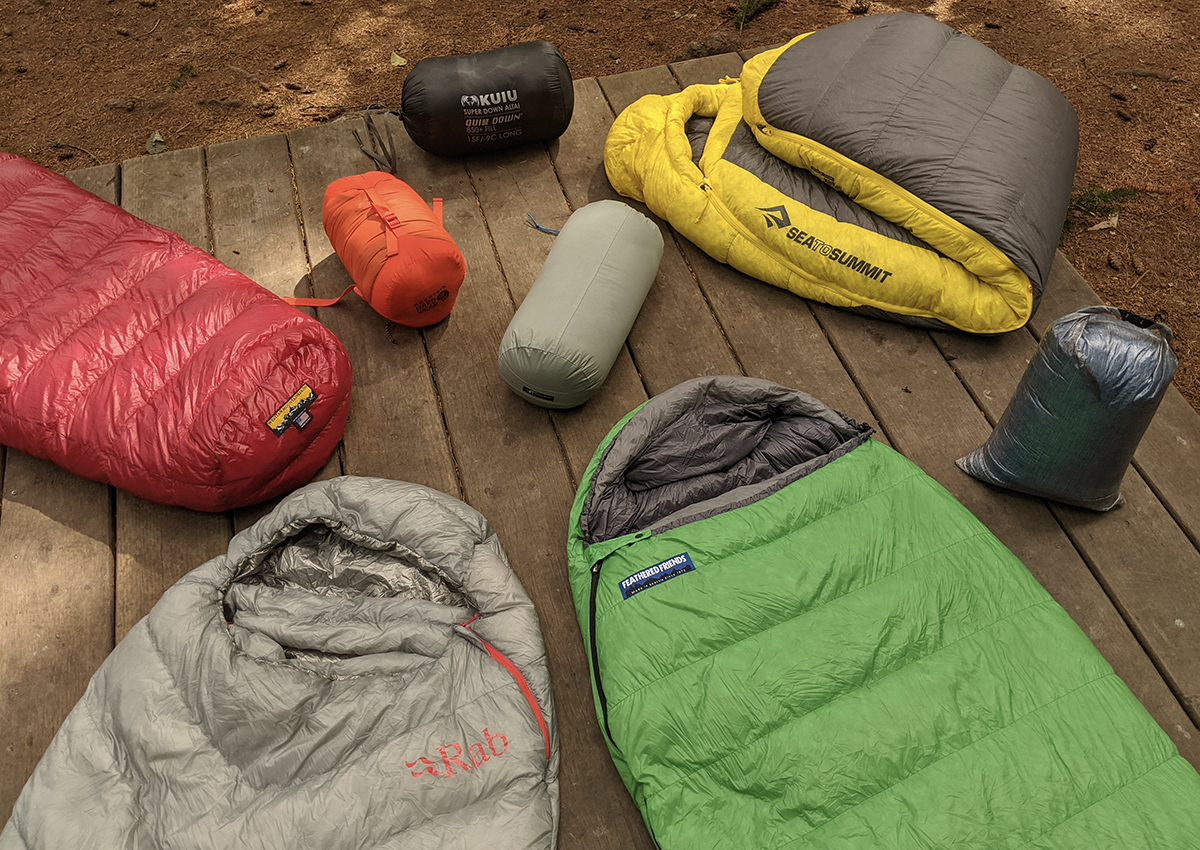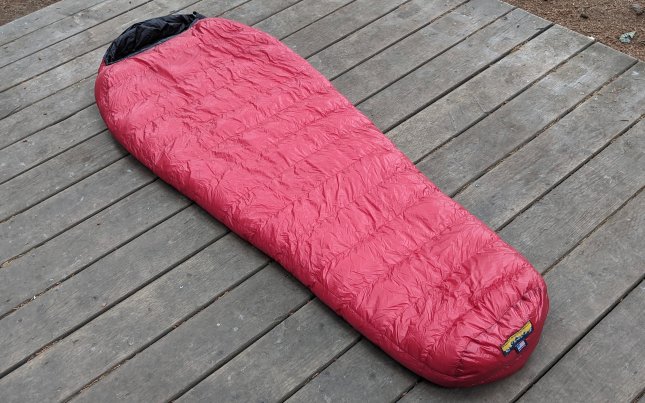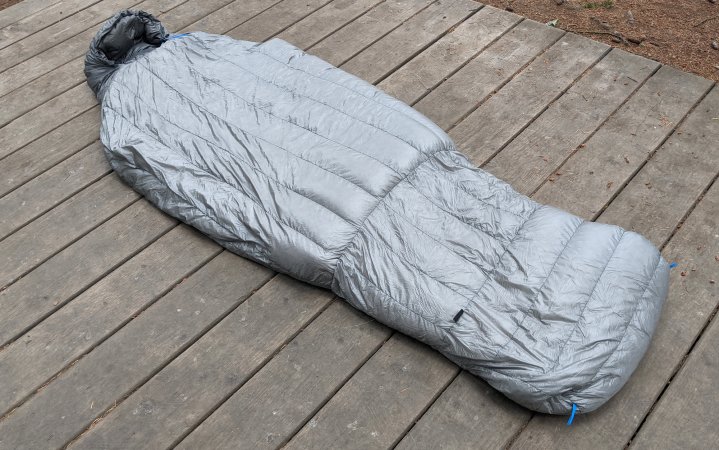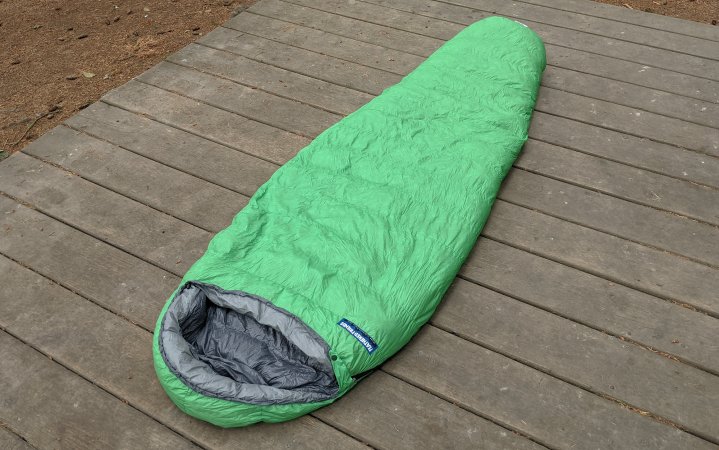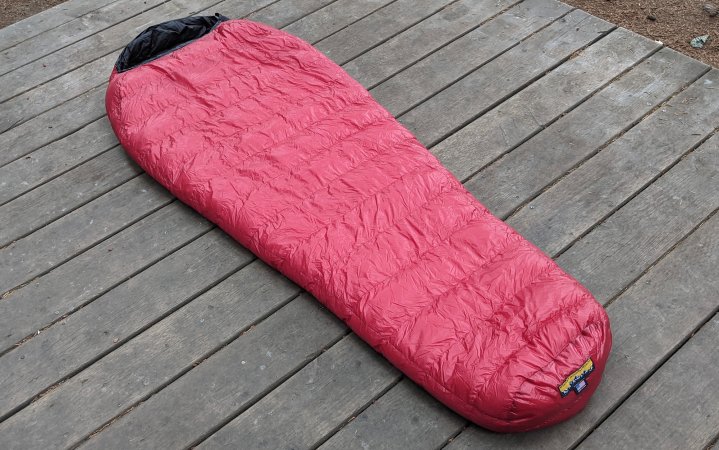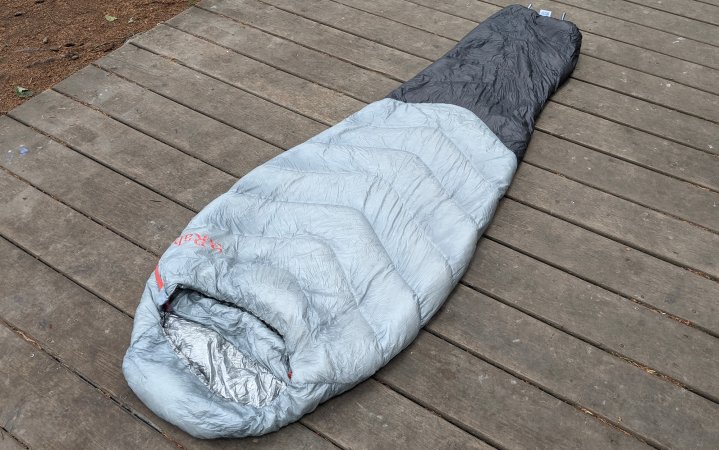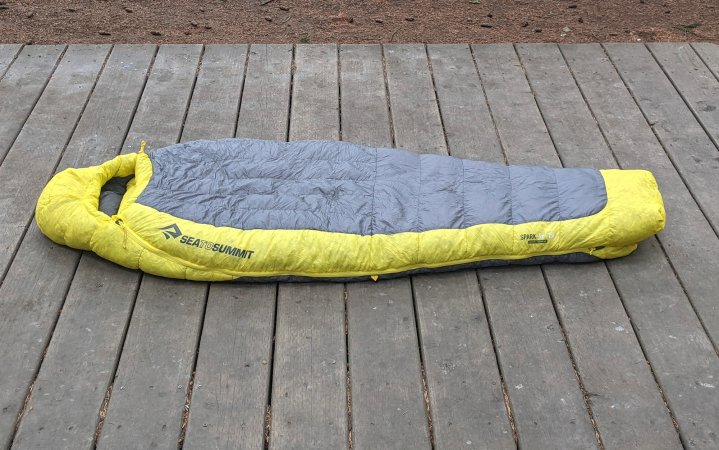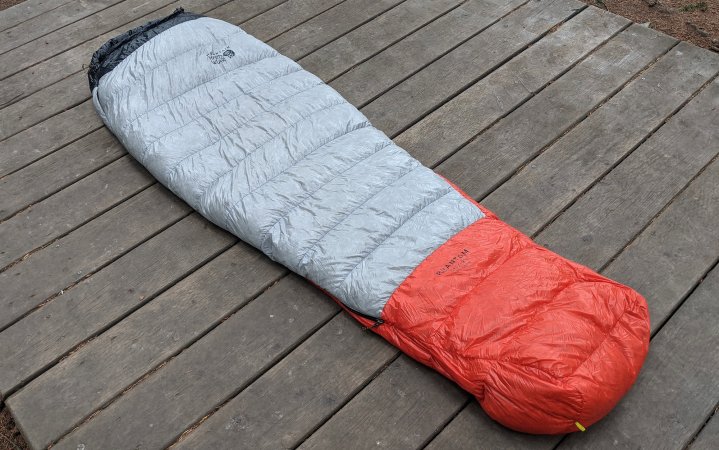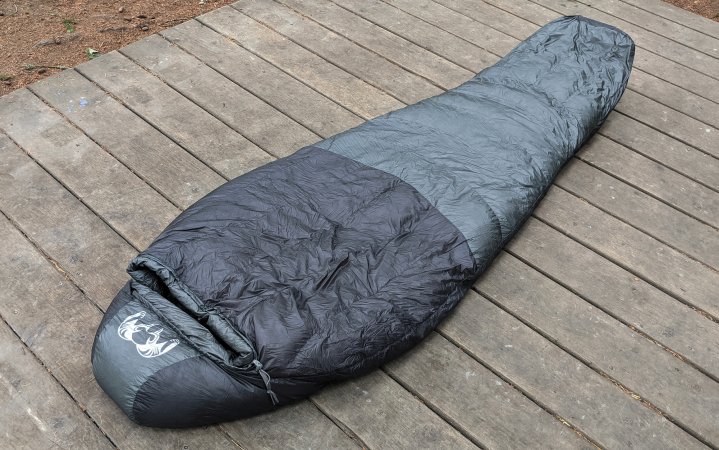We may earn revenue from the products available on this page and participate in affiliate programs. Learn More ›
Dollar for ounce, no part of an ultralight backpacker’s kit is more costly to cut down on weight than the sleep system. Premium down — we’re talking 800 or even 900 fill power — costs exponentially more than the standard 550 fill power down used in typical sleeping bags. To help you make the right choice before you drop half a grand, we tested options from the likes of Feathered Friends, Stone Glacier, Western Mountaineering, Rab, and more to find which ones perform the best out in the field.
- Best for Men: Stone Glacier Chilkoot
- Best for Women: Feathered Friends Egret UL
- Best Upgrade: Western Mountaineering AlpinLite
- Best Hoodless: Zpacks Classic
- Lightest: Rab Mythic
- Sea to Summit Spark
- Mountain Hardwear Phantom
- Kuiu SuperDown Altai
How We Tested the Best Ultralight Sleeping Bags
Selection
More than any other category in ultralight backpacking, the smaller companies making ultralight sleeping bags are setting the bar for quality. Outdoor Life was fortunate enough to have the likes of Western Mountaineering and Feathered Friends send us loaners for our testers to check out.

We pitted them against ultralight hunting brands Stone Glacier and Kuiu as well as premium mainstream brands Sea to Summit and Mountain Hardwear. Ultralight backpacking mainstay Zpacks and UK-headquartered Rab rounded out our testing list.
The Testers
Outdoor Life conducts an annual backpacking gear testing trip that focuses on innovative lightweight and ultralight backpacking gear. These testing trips take place on America’s national scenic trails, including a 30-mile stretch of the northernmost section of the Oregon Coast Trail (where we tested the best backpacking quilts) and a 40-mile stretch along the Pacific Crest Trail in the Goat Rocks Wilderness.

- Adam Tycaster: Over 4,000 miles of backpacking experience, including the PCT 2014 and CT 2017. Runs cold.
- Alex Robinson: OL editor-in-chief; a backcountry big game hunter and fair-weather trail runner. Runs warm.
- Ashley Thess: OL associate gear editor. Over 600 miles of backpacking experience. Runs cold.
- Diana Helmuth: Author of How to Suffer Outside (National Outdoor Book Award winner). Over 1,500 miles of backpacking experience. Runs cold.
- Jac “Top Shelf” Mitchel: Over 11,000 miles of backpacking experience including the PCT 2014, CDT 2016, AZT, 2017, and GET 2017. Runs cold.
- Laura “Chop Chop” Lancaster: OL staff writer. Over 4,000 miles of backpacking experience, including the PCT 2014 and CT 2017. Runs warm.
- Patrice “Steady” La Vigne: Gear reviewer, Denali guide, and author of Between Each Step. Over 7,000 miles of backpacking experience, including the AT 2011 and Te Araroa 2014-2015. Runs cold.
- Sven “Magic” Anderson: 1,350-mile LASH (PCT) 2022. Hiking with Parkinson’s disease. Runs cold.
Scoring
Each tester was assigned a sleeping bag based on their size and whether they ran hot or cold. While most sleeping bags in our test were rated between 10 to 15 degrees, a couple were in the 25 or even 30 degree range. After taking copious notes in the field, the testing team then spends a day filling out scoring sheets for each item in the test, including their ultralight sleeping bags. Testers then presented to the group the sleeping bag they tested, along with their experience. The group then discussed which sleeping bag most impressed them.

Ultralight sleeping bags were rated on the following metrics.
- Comfort: This includes the feel of the fabric against testers’ skin, and whether there was enough space for them to comfortably sleep inside the bag.
- Warmth: Testers evaluated whether the stated temperature rating matched their expectations for a limit rating. The limit rating — what is typically used for backpacking sleeping bags — describes the lowest temperature that a sleeping bag would be safe to use.
- Interior Space: Our testers came in all shapes and sizes and provided feedback as to whether the sleeping bag they slept was too big, too small, or just right.
- Water Repellency: Did moisture, including condensation occurring within the tent and within the sleeping bag, compromise the ability of the down to loft? When it did get wet, did it dry quickly?
- Value: Was the sleeping bag worth the price tag?
Testers also described their experience with the hood of each of the below sleeping bags, which was taken into consideration when determining the top picks. Weight was measured independently, and includes the provided stuff sack. Finally, we took price into consideration.
Comparison Table
The user ratings describe the relative experience each of our testers had with the sleeping bag they tested. An effort was made to provide individuals with sleeping bags that appropriately matched their body type and internal thermostat. The spec comparisons table drills down on the relative differences in price and weight, which vary substantially depending on size and the fill power being used for each sleeping bag.
User Ratings
| Sleeping Bag | Fits | Available Temperature Ratings | True to Temp Rating? | Comfort | Interior Space | Water Repellency | Value |
| Feathered Friends Egret UL | Smaller users | 20F 30F | Yes | 5 | 4 | 4 | 4 |
| Kuiu SuperDown Altai | Taller users | 15F 30F 45F | Yes | 4 | 4 | 4 | 3 |
| Mountain Hardwear Phantom | Average men | 0F 15F 30F | Runs slightly cold | 3 | 3 | 4 | 3 |
| Sea to Summit Spark Women’s | Average women | 15F 30F 45F | Yes | 4 | 2 | 4 | 4 |
| Stone Glacier Chilkoot | Taller and wider users | 0F 15F | Yes | 5 | 3 | 4 | 3 |
| Rab Mythic | Average men | 32F | Runs cold | 4 | 3 | 4 | 4 |
| Western Mountaineering AlpinLite | Everyone | 20F | Runs slightly cold | 4 | 4 | 5 | 3 |
| Zpacks Classic | Almost everyone | 10F 20F 30F | Runs cold | 5 | 5 | 4 | 4 |
Spec Comparisons
| Sleeping Bag | Max User Height | Price | Weight | Fill Power | Fill Weight | EN/ISO Tested? |
| Feathered Friends Egret UL | S: 5’3” M: 5’9” | S 20F: $589 M 20F: $609 S 30F: $529 M 30F: $549 | S 20F: 1 lb, 9.6 oz M 20F: 1 lb, 11.2 oz S 30F: 1 lb, 7.5 oz M 30F: 1 lb, 8.8 oz | 950 fp | S 20F: 1 lb, 0.3 oz M 20F: 1 lb, 1.3 oz S 30F: 13.3 oz M 30F: 14 oz | No |
| Kuiu SuperDown Altai | M: 6’ L: 6’6” | M 0F: $750 L 0F: $800 M 15F: $600 L 15F: $660 | M 0F: 2 lbs, 7.3 oz L 0F: 2 lbs, 12.2 oz M 15F: 1 lb, 13.6 oz L 15F: 2 lbs, 0.4 oz | 850 fp | M 0F: 1 lb, 14 oz L 0F: 2 lbs, 1 oz M 15F: 1 lb, 3 oz L 15F: 1 lb, 6 oz | Yes — 13F Limit for 15F option |
| Mountain Hardwear Phantom | S: 5’8” M: 6’ L: 6’6” | S 0F: $670 M 0F: $680 L 0F: $710 15F: $580 30F: $480 | 0F: 2 lbs, 10.6 oz 15F: 2 lbs, 1.2 oz 30F: 1 lb, 6.3 oz | 800 fp | S 0F: 1 lb, 12.4 oz M 0F: 1 lb, 14.5 oz L 0F: 2 lbs, 0.6 oz S 15F: 1 lb, 3.4 oz M 15F: 1 lb, 4.2 oz L 15F: 1 lb, 6 oz S 30F: 9.7 oz M 30F: 10.1 oz L 30F: 11 oz | Yes — 25F Limit for 30F option |
| Sea to Summit Spark Women’s | M: 5’7” L: 6’1” | M 15F: $550 L 15F: $580 M 30F: $450 L 30F: $480 M 45F: $350 L 45F: $380 | M 15F: 2 lbs, 0.8 oz L 15F: 2 lbs, 4.2 oz M 30F: 1 lb, 4.6 oz L 30F: 1 lb, 6.5 oz M 45F: 13.5 oz L 45F: 15.2 oz | 850 fp | M 15F: 1 lb, 8.2 oz L 15F: 1 lb, 11.5 oz M 30F: 13.2 oz L 30F: 15.2 oz M 45F: 7.1 oz L 45F: 8.1 oz | Yes — 5F Limit for 15F option |
| Stone Glacier Chilkoot | 6’5” | 0F: $650 15F: $600 | 0F: 2 lbs, 10 oz 15F: 2 lbs, 3 oz | 850 fp | 0F: 1 lb, 13.1 oz 15F: 1 lb, 6.4 oz | Yes — 8F Limit for 15F option |
| Rab Mythic | M: 6’1” L: 6’7” | M 18F: $750 L 18F: $770 M 32F: $600 L 32F: $650 | M 18F: 1 lb, 6.7 oz L 18F: 1 lb, 8.9 oz M 32F: 15.5 oz L 32F: 1 lb, 0.9 oz | 900 fp | 18F: 12.1 oz 32F: 6.3 oz | Yes — 35F Limit for 32F option |
| Western Mountaineering AlpinLite | S: 5’6” M: 6’ L: 6’6” XL: 7’ | S 20F: $685 M 20F: $710 L 20F: $730 XL 20F: $750 | S 20F: 1 lb, 13 oz M 20F: 1 lb, 15 oz L 20F: 2 lbs, 1 oz XL 20F: 2 lbs, 4 oz | 850 fp | S 20F: 1 lb, 1 oz M 20F: 1 lb, 3 oz L 20F: 1 lb 5 oz XL 20F: 1 lb, 7 oz | Yes —14F Limit for 20F option |
| Zpacks Classic | S: 5’6” M: 6’ L: 6’6” | See below | See below | 900 fp | See below | No |
Best Ultralight Sleeping Bags: Reviews & Recommendations
Best for Men: Stone Glacier Chilkoot
Pros
- Soft material
- Pillowy draft collar with a gentle magnetic closure
- Generous bill on a roomy hood
- Plenty of room for side sleepers
- Great warranty
Cons
- Confusing zipper
- Noticeably heavier than advertised
- No option available for warmer conditions
- Only one height available that is not appropriate for shorter individuals
Report Card
- Comfort: 5
- Interior Space: 4
- Water Repellency: 4
- Value: 3
- True to temperature rating
- Measured Weight of the 15-Degree Bag: 2 pounds, 8.6 ounces (5.6 ounces more than advertised)
- PFAS free in 2025
Key Features
- Temperature Rating: 0F and 15F
- Price: $600 (15F) to $650 (0F)
- 850 fill power
- Shell: 15D Pertex
- Length: Fits people up to 6 feet 5 inches
- Warranty: Limited lifetime
15-degree bag tested by Adam Tycaster in the Goat Rocks Wilderness
Too often ultralight sleeping bags compromise interior space to cut ounces. Not only is this annoying for side sleepers, but it can make it tough for heftier individuals to squeeze inside at all. So the testing team was impressed when they saw just how much extra interior space was in the Stone Glacier Chilkoot, easily the widest option we looked at.

Tycaster was also impressed by how comfortable this sleeping bag was. “It felt silky and soft,” he said, noting that it had a, “full hood that encircles the face and felt pillowy at the brow.” One detail that stood out on the Stone Glacier Chilkoot was the magnetic closure for the draft collar, which made it easy to open and close.
The only confounding part of the Chilkoot sleeping bag for our tester was the two-way zipper. While sleeping bag zippers typically run up along the left or right edge, on the Chilkoot, it forms more of an arc, starting closer to top center of the bag near the user’s knees, arcing out to the side, and then curving back in where it zips up to the neck. In the field, Tycaster found that he was struggling to zip and unzip the bag — especially when he had rolled onto his side and gotten twisted up in the middle of the night.

Men who are on the shorter side should also note that the Chilkoot is only available in one length. Sleeping bags that are excessively long may feel colder, as there is more excess air in the bag that needs to be warmed up.
Best for Women: Feathered Friends Egret UL
Pros
- Smaller size means a better fit, less expense, and less weight for smaller individuals
- Made in the USA
- Great warranty
Cons
- Slipped off of the sleeping pad easily
- Lost a few feathers during our testing trip (not from a tear)
Key Features
- Temperature Rating: 20F and 30F
- Price: $589 to $609
- 950 fill power
- Shell: Pertex
- Length: Small fits people up to 5 feet 3 inches; medium fits 5 feet 9 inches
- Warranty: Limited lifetime
20-degree medium bag tested by Patrice “Steady” La Vigne in the Goat Rocks Wilderness
Report Card
- Comfort: 5
- Interior Space: 4
- Water Repellency: 4
- Value: 4
- True to temperature rating
- Measured Weight of the 20-Degree Bag: 1 pounds, 13.3 ounces (2.1 ounces more than advertised)
- Free from intentionally added PFAS (some PFAS in the paint on the zipper pulls at present)
Steady raved about the Feathered Friends Egret after our Goat Rocks Wilderness testing trip. She was more than impressed with the 20F temperature rating — overkill, as it turned out, for our mid-season alpine trek.

“The 20-degree Egret was cozy and snug,” said Steady. “I liked that the two-way zipper allowed for temperature regulation. I slept with it unzipped from my feet to my waist most nights.” Steady noted that, even though it wasn’t a roomy bag, there was still plenty of room for side sleeping. “I slept comfortably inside even with my tossing and turning, and did not get all twisted in the bag.”

Smaller details were also appreciated on the Feathered Friends Egret. The hood was “form fitting and super snuggly,” and the zipper was draft free, even on the windiest night of our test. It packed down to the size of a loaf of bread.

“I’m extremely impressed,” concluded our tester.
Best Upgrade: Western Mountaineering AlpinLite
Pros
- Available in a wide range of heights
- Comfortable width for users across a range of body types
- Made in the USA
- Great warranty
Cons
- Expensive
Report Card
- Comfort: 4
- Interior Space: 4
- Water Repellency: 5
- Value: 3
- Runs slightly cold
- Measured Weight of the 20-Degree Bag: 1 pound, 15.1 ounces (0.1 ounce more than advertised)
- Free from intentionally added PFAS
Key Features
- Temperature Rating: 20F
- Price: $670 to $730
- 850 fill power
- Shell: 12D nylon ripstop
- Length: Small fits people 5 feet 6 inches; medium fits 6 feet; large fits 6 feet 6 inches; XL fits 7 feet
- Warranty: Limited lifetime
20-degree medium bag tested by Diana Helmuth in the Goat Rocks Wilderness
The most expensive ultralight sleeping bag we looked at more than delivered the goods as far as our tester was concerned. “I could immediately tell I was sleeping in a premium bag,” Helmuth said. “Like a top tier duvet — silky, lofty, deliciously warm.”

Helmuth did experience some condensation, inside the Zpacks Free Duo, on our trek through the Goat Rocks Wilderness, which impacted the sleeping bag near the footbox. This was especially noteworthy, as Western Mountaineering does not use hydrophobic treatments on the down in their products. Here’s their explanation for not treating down:
“We have found in our own testing that the performance enhancements of hydrophobic treatments on high quality down are widely overstated. High quality untreated down already has naturally water repellant oils on it left by the geese (makes sense since geese spend a lot of time in water). These oils help repel water and keep down lofted. More importantly is that these oils last indefinitely. Hydrophobic treatments wash out like a DWR and remove the natural oils during the application process. Because of this, and the water resistant capability of our shell fabrics, we feel that hydrophobic down does not provide a considerable impact on performance and could actually inhibit performance over the lifetime of our products.”

While actual submersion might be a different story, our tester was impressed with how the Western Mountaineering AlpinLite handled condensation. “I never felt it,” Helmuth reported. “It dried in the sun in less than a minute.”

Really the only issue with the Western Mountaineering AlpinLite is that, per our tester, it ran slightly colder than expected — more in line with the 25 comfort rating it has per the EN test Western Mountaineering had run on it (scroll down on their FAQs for more info on this). On our coldest night of testing, Helmuth shook out the bag to redistribute the down, saying it made the bag feel 10 to 15 degrees warmer.
Best Hoodless: Zpacks Classic
Pros
- Three length, three width, and three temperature rating options offers plenty of customization
- Lower priced than other options on this list
- Very lightweight
Cons
- Temperature rating runs cold
Report Card
- Comfort: 5
- Interior Space: 5
- Water Repellency: 4
- Value: 4
- Runs cold
- Measured Weight: 1 pounds, 11.2 ounces (1.6 ounces more than advertised + 0.9 ounce stuff sack)
- Free of intentionally added PFAS
Key Features
- Temperature Rating: 10F, 20F, 30F
- Price: $440 to $520
- 900 fill power
- Shell: 7D ripstop nylon
- Length: Shorts fits 5’6”; medium first 6’; long fits 6’6” (also has three width options)
- Warranty: 2 years
10-degree medium broad tested by Ashley Thess in the Goat Rocks Wilderness
Because hoods are so effective at locking in warm air, almost all ultralight sleeping bags have them. But that doesn’t mean that everyone uses them; user feedback during our Goat Rocks Wilderness test showed a clear split. Half the testers saw them as indispensable. Half the testers only used them to hold their pillows in place. Personally, I find them a little annoying as I’m forever waking up to find I’ve twisted the hood into a distracting position. If I need to keep my head warm at night, I’ll throw on one of the best down jackets with a hood.

While OL associate editor Ashley Thess may have discovered that she is the staunchly pro-hood camp during her test of the Zpacks classic sleeping bag, she came away impressed by virtually every other detail. The zipper that went down to the footbed made it a cinch to get into the broad medium — which she found to be wider than necessary for her standard frame — with just the right number of clasps and bungees to keep everything in place.

“I was so comfortable,” reported Thess. “Great skin feel and the largest range of motion of any sleeping bag I’ve ever tested.” It’s worth noting that while the Zpacks Classic uses a 7D fabric for the shell, there were no tears during our test.

Finally, the sheer range of customization available for the Zpacks Classic sleeping bag is impressive, and important for ultralight backpackers. Getting a just right size and fit can mean substantial weight and monetary savings, as the below table demonstrates.
| Zpacks Classic Size | Temperature Rating | Price | Weight | Fill Weight |
| Slim Short | 10 | $440 | 1 lb, 4.5 oz | 15.6 oz |
| Length: 68” | 20 | $420 | 1 lb, 0.6 oz | 12 oz |
| Width: 55” | 30 | $400 | 12.3 oz | 7.8 oz |
| Slim Medium | 10 | $460 | 1 lb, 5.7 oz | 1 lb, 0.6 oz |
| Length: 74” | 20 | $440 | 1 lb, 1.3 oz | 12.7 oz |
| Width: 55” | 30 | $420 | 13 oz | 8.3 oz |
| Standard Short | 10 | $460 | 1 lb, 5.9 oz | 1 lb, 0.8 oz |
| Length: 68” | 20 | $450 | 1 lb, 1.8 oz | 12.9 oz |
| Width: 60” | 30 | $420 | 13.1 oz | 8.4 oz |
| Standard Medium | 10 | $480 | 1 lb, 7.2 oz | 1 lb, 1.8 oz |
| Length: 74” | 20 | $460 | 1 lb, 2.2 oz | 13.7 oz |
| Width: 60” | 30 | $440 | 13.8 oz | 8.9 oz |
| Standard Long | 10 | $500 | 1 lb, 8.5 oz | 1 lb, 2.8 oz |
| Length: 80” | 20 | $480 | 1 lb, 3.8 oz | 14.4 oz |
| Width: 60” | 30 | $460 | 14.5 oz | 9.4 oz |
| Broad Medium | 10 | $500 | 1 lb, 8.7 oz | 1 lb, 3 oz |
| Length: 74” | 20 | $480 | 1 lb, 4 oz | 14.6 oz |
| Width: 65” | 30 | $460 | 14.6 oz | 9.5 oz |
| Broad Long | 10 | $520 | 1 lb, 9.9 oz | 1 lb, 4 oz |
| Length: 80” | 20 | $500 | 1 lb, 5 oz | 15.4 oz |
| Width: 65” | 30 | $480 | 15.4 oz | 10 oz |
Lightest: Rab Mythic
Pros
- The lightest sleeping bag we tested
- Very small packed size
- Great warranty
Cons
- Somewhat less warm than advertised
- Difficult to get into
Report Card
- Comfort: 4
- Interior Space: 3
- Water Repellency: 4
- Value: 4
- Runs cold
- Measured Weight of the 32-Degree Bag: 1 pound, 1.5 ounces (2 ounces more than advertised)
- PFAS free
Key Features
- Temperature Rating: 18F and 32F
- Price: $600 (32F) to $770 (18F)
- 900 fill power
- Shell: 10D nylon
- Length: Regular fits people up 6 feet 1 inch, long fits up to 6 feet 6 inches
- Warranty: Limited lifetime
32-degree regular tested by Laura “Chop Chop” Lancaster in the Goat Rocks Wilderness
No ultralight sleeping bag raised more eyebrows in our test than the Rab Mythic. Packed up, it looked about half the size of the other options we tested, and it had the weight to match. But it also looked a lot less substantial than the others.
Because I tend to run warm, I tested the 32F version of this sleeping bag, which has only 6.3 ounces of 900 fill power down. Compare that to the Mountain Hardwear Phantom 30F, which has 10.1 ounces of down. The reason the Rab Mythic thinks it can get away with a third less down is that it’s using a new kind of fabric in the liner made from a nylon yarn treated with titanium. The idea is that it’s supposed to reflect heat back to the user, sort of like a space blanket.

All things considered, this actually worked pretty well. I wasn’t quite as warm as I expected to be (or wanted to be) for the 32F temperature rating, but I was certainly much warmer than I expected to be looking at the Rab Mythic. If I had snagged the 18F version rather than the 32F version, I suspect I would have been toasty, even on our coldest night of testing. As it was, I slept in my puffer jacket that night and did just fine.

Typically the high cost of high fill-power down is what drives up the price of warmer sleeping bags — this is one of the few categories where you’ll pay more for the longer version of a product and less for the shorter version. So I was surprised that, despite the comparative lack of down in the Rab Mythic, the price point was still as high or higher than other options we tested. For now, this one is best suited for extreme ultralighters who know they run hot.
Sea to Summit Spark Women’s
Pros
- Competitively priced
Cons
- Narrow profile
- Runs short
Report Card
- Comfort: 4
- Interior Space: 2
- Water Repellency: 4
- Value: 4
- True to temperature rating
- Measured Weight of the Regular 15-Degree Bag: 2 pounds, 3.8 ounces (3 ounces more than advertised)
- PFAS free
Key Features
- Temperature Rating: 15F, 30F, and 45F
- Price: $350 (45F) to $580 (15F)
- 850 fill power
- Shell: 10D nylon
- Length: Regular fits up to 5 feet 7 inches, long fits up to 6 feet 1 inch
- Warranty: Limited lifetime
15-degree regular tested by Jac “Top Shelf” Mitchell in the Goat Rocks Wilderness
While the Sea to Summit Spark Women’s kept our tester warm through the coldest night of our backpacking gear test, it didn’t stand out for comfort or interior space compared to other options that we looked at. For the women’s version of this bag, Sea to Summit altered the design to have narrower shoulders and more space at the hips. Unfortunately, for our tester, there wasn’t enough room left at the feet, which restricted her range of motion. This one also runs a bit short compared to other sleeping bags we looked at — if you are close to the upper limit for height then consider sizing up.

All that being said, the Sea to Summit Spark Women’s is competitively priced compared to others that we looked at, making it a good bet for committed back sleepers with average to narrow shoulders.
Mountain Hardwear Phantom
Pros
- Competitively priced
- Good skin feel
- Great warranty
Cons
- A little heavy
Report Card
- Comfort: 3
- Interior Space: 3
- Water Repellency: 4
- Value: 3
- Runs slightly cold
- Measured Weight of the 15-Degree Bag: 2 pounds, 4.5 ounces (3.4 ounces more than advertised)
- PFAS free
Key Features
- Temperature Rating: 0F, 15F, and 30F
- Price: $480 (30F) to $710 (0F)
- 800 fill power
- Shell: 15D nylon ripstop
- Length: Small fits up to 5 feet 8 inches, medium fits up 6 feet, long fits up 6 feet 6 inches
- Warranty: Limited lifetime
15-degree regular tested by Sven “Magic” Anderson in the Goat Rocks Wilderness
The Mountain Hardwear Phantom is a well-priced ultralight sleeping bag that gets the job done. While some of the features — such as the draft collar and hood — were more minimal than other options we looked at, they kept our tester plenty warm during the testing trip in the Goat Rocks Wilderness.

Magic also gave the skin feel the highest possible praise, which is that he barely noticed it.
Kuiu SuperDown Altai
Pros
- The tallest sleeping bag in our test
- Surprisingly lightweight
- Great warranty
Cons
- Narrower than other options we tested
- Tear in the 7D shell occurred during testing
Report Card
- Comfort: 4
- Interior Space: 4
- Water Repellency: 4
- Value: 3
- True to temperature rating
- Measured Weight: 2 pounds, 1.7 ounces (1.3 ounces more than advertised)
- Does contain PFAS
Key Features
- Temperature Rating: 15F
- Price: $600 to $660
- 850 fill power
- Shell: 7D ripstop nylon
- Length: Regular fits up to 6 feet; long fits up to 6 feet 6 inches
- Warranty: Limited lifetime
15-degree long bag tested by Alex Robinson in the Goat Rocks Wilderness
Even above treeline, with a consistent breeze running across the remaining snow patches in the Cascades, the Kuiu SuperDown Altai was too warm for OL editor-in-chief Alex Robinson. But he was still impressed with some key details. A glow-in-the-dark pull was useful for getting in and out of the bag at night. The hood was plush and comfy. And the tall was quite tall — when 6-foot-1 Robinson showed us how much extra room there was above his head in the long, it was clear it would definitely fit a user up to 6-foot-6. (If you’re even taller than that, check out our best upgrade picks, which goes up to 7 feet tall).

Unfortunately, the Kuiu SuperDown Altai was the only sleeping bag in our test to suffer a tear, at one of the snap-button connection points.
How to Choose the Best Ultralight Sleeping Bag
The R Value of Your Sleeping Pad
Many sleeping bag users don’t worry about the R value of their sleeping pad, assuming that the pad is there for comfort, and that it’s their sleeping bag keeping them warm. But the sleeping bag insulation that is beneath your body is not providing the same level of warmth as the rest of your bag. That’s because it’s not the insulation itself that’s keeping you warm so much as the warm air trapped inside of the insulation (the “loft”), which serves as a buffer to the outside temperature. The insulation that you are lying on has no loft (your body is squashing it), and so provides significantly less warmth. It doesn’t provide no insulation, in the same way that an unlofted puffer jacket isn’t exactly worthless, but it’s nowhere near as effective.
Read Next: What Is R Value? It’s Why Your Sleeping Bag Doesn’t Keep You Warm
The R value of a backpacking sleeping pad refers to its ability to “resist” temperature transference from one side of the pad to the other. Higher R values mean better resistance, with an R value of 1 generally referring to little to no resistance, 4 being the level of resistance necessary to enjoy the full temperature rating of your sleeping bag, and 7+ being what most people should carry for winter camping.
Read Next: The Best Backpacking Sleeping Pads
This is especially important for shoulder season and alpine backpacking as the temperature of the ground at altitude will tend to lag behind the outside air temperature. So even if the air temperature around you is, say, 40 degrees, that doesn’t mean that’s the temperature of the ground. A 4 R value is ideal for high elevation summer activities.
Temperature Rating
Sleeping bags typically advertise their “limit” ratings — the temperature at which they can be safely used, but not the temperature at which you will still be warm (the “comfort” rating). In the above story, we treated all degree ratings as if they were limit ratings for standardization purposes and then provided our take on whether they ran hot, cold, or true to temperature.
Most people should choose a limit rating for their sleeping bag that is 20 degrees lower than their lowest expected temperature. So, if you expect overnight lows to reach 50 degrees, order a 30-degree ultralight sleeping bag. If you expect they will hit 30 degrees, order a 10-degree ultralight sleeping bag. (Note that if a sleeping bag lists a comfort rating, that is usually 10 to 15 degrees warmer than the limit rating.) With experience, you’ll learn if you run hotter or colder, and can adjust accordingly.
Fill
Ultralight sleeping bags are made from down for one simple reason: It still has superior warmth-to-weight ratios compared to synthetic fill. With down, the higher the fill power the less you’ll need to reach your desired temperature rating, and thus the less your ultralight sleeping bag will weigh. The difference between, say 850 fill power and 950 fill power for an ultralight sleeping bag might only be a couple of ounces, but cost upwards of $100. Consider your priorities when choosing which one is the right pick for you.
Ultralight sleeping bags are never made from synthetic insulation as synthetic is not able to achieve the warmth for weight properties of high-grade down. The best synthetic insulation is about 600 fill power, while the ultralight sleeping bags we looked at started at 800 fill power.
Material
The majority of ultralight sleeping bags use nylon to encase the down, often with a DWR (durable water repellent) finish on the part of the sleeping bags that is exposed to the outside air (the shell). Where most differ is in the thickness of the nylon — measured in denier (D) — which can be anywhere from 7D up to 20D. Thicker materials will tend to be more durable over time (and may result in less natural down loss), while thinner materials will contribute to an overall lower weight. Which one is right for you is a matter of personal preference.
Storage
Ultralight sleeping bags typically come with stuff sacks for travel, but it’s not necessary to use this feature. In fact, you can skip the stuff sack entirely and squash your ultralight sleeping bag to the bottom of your bag before piling other items on top (just be careful that you don’t snag anything on your bag). It’s best to put your ultralight sleeping bag in a larger storage sack at home, as compressing the down long-term will shorten its usable lifespan.
FAQs
The mummy style of sleeping bag — so called because it looks a bit like a sarcophagus — is the most effective shape for locking in warmth and keeping the weight down. It minimizes extra space around the footbox and across the length of your body and blocks drafts from escaping at the face opening. For some people, this is a comfortable enough way to sleep; others find it less so. Another issue with this style of sleeping bag is that it typically does not offer enough width to accommodate large individuals. We’ve noted above which sleeping bags offer wide sizing options or naturally run wide.
Ultralight sleeping bags are ridiculously expensive — the “cheapest” option we looked at was $500. That’s hundreds of dollars more than you’ll spend on the best ultralight tent or ultralight backpack. So what gives?
Read Next: Down vs. Synthetic Sleeping Bags
It’s the down. Goose and duck down are rated by fill power, which measures how much volume a single ounce of down takes up. That’s important because the reason down is warm in the first place is that it traps air inside its plumes, creating a barrier between your body and the cold outside air. The more air a plume of down can capture, the better it can shield you from the cold, and the less of it you need to stay warm. And it’s always down we’re talking about when it comes to ultralight sleeping bags; at least for now, synthetics don’t have the necessary warmth to weight performance.
Read Next: Primaloft vs Down
Most down used in commercial products is in the 550 fill power range, which means that an ounce of down will fill up 550 cubic inches when fully lofted. This quality of down is typically harvested from ducks and geese after they’ve been slaughtered for consumption. The down used in ultralight sleeping bags is typically in the 800 to 900 fill power range. This down is typically only found on mature geese, kept as breeding livestock. Because the down can only be ethically harvested at the end of the animal’s life, high-fill power is considerably rarer — and thus more much expensive — than lower fill power down.
How warm a 20-degree sleeping bag is will depend on a few things. The first is what the sleeping bag manufacturer means by 20 degrees. Some mean that you will survive temperatures down to 20 degrees; others mean that you will be warm and comfortable at that temperature. The former is described as a limit rating while the latter is described as a comfort rating. For more dubious manufacturers, like you might find at Walmart, 20 degrees is more aspirational (and almost certainly not third-party tested). The other important factor is you: Some people run very cold and will need more insulation to stay warm at 20 degrees than others.
Final Thoughts
A great ultralight sleeping bag can be a lifetime investment, if treated with care. The below picks were all trail tested side-by-side with an experienced crew of backpackers. We’re confident that any of them would serve you well for years to come.
- Best for Men: Stone Glacier Chilkoot
- Best for Women: Feathered Friends Egret UL
- Best Upgrade: Western Mountaineering AlpinLite
- Best Hoodless: Zpacks Classic
- Lightest: Rab Mythic
- Sea to Summit Spark
- Mountain Hardwear Phantom
- Kuiu SuperDown Altai
